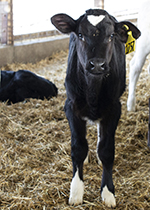
With the holidays and the kick-off to the new year, we received gifts in many forms. One that was a little overabundant was the surplus of calves being born on our farm. While newborn calves are essential and a positive for our dairy operation, the number that came at one time and the rounds of sickness they experienced this past month were a bit much to handle.

Between the weather, tight quarters, and a virus that was making its way through all the calves, you could say that December was a tough month in our calf building. We battled to help each calf by providing extra nutrition, additional feedings, extreme sanitation everywhere, and medication. At one point, we had calves separated between our heated shop, some in our heated milk room, a bunch in our usual individual pens, and we even started using our older style outdoor calf hutches again to keep new calves away from infected areas.
With the help of our vet and some testing, we identified a couple viruses responsible for the massive influx of illness among our young stock. Fortunately, we have several new products and treatment methods in place to help get everyone back to good health. The rush of births has also slowed down dramatically with the start of the new year, so we’re in much higher spirits with getting everything back on track after a rough month.
Here’s hoping 2023 continues to bring health and happiness to our animals and people!

The author dairy farms with her parents and brother near Hawkeye, Iowa. The family milks approximately 300 head of grade Holstein cows at Windsor Valley Dairy LLC — split half and half between a double-eight parallel milking parlor and four robotic milking units. In the spring of 2020, Molly decided to take a leap and fully embrace her love for the industry by returning full time to her family’s dairy.







